Ashton-under-Lyne Corporation Tramways
History
The first operational tramway in Ashton was a standard-gauge horse line to Stalybridge, which was built and operated by the Manchester Carriage and Tramways Company Limited; services commenced on the 4th of June 1881, and were extended later that year westwards to meet with the MC&TCo's existing Manchester line at Audenshaw.
Twenty years later — on the 12th June 1899 — the first electric trams ran in Ashton, though still not operated by the corporation, but by the Oldham, Ashton-under-Lyne and Hyde Electric Tramways Company Limited (a subsidiary of the British Electric Traction Company Limited); the line ran from Hathershaw in the north, through Ashton and Denton, to Hyde in the south.
Ashton Corporation was, however, keen to have an electric tramway system of its own, so powers were acquired — along with neighbouring Hurst Urban District Council — to construct a standard-gauge tramway in the two boroughs. The first lines completed included those in Hurst; these were opened on the 16th August 1902 and were operated by Ashton under a lease agreement. The corporation was naturally keen to electrify the main east-west route through the town, so on the 31st March 1903, it duly exercised its right to purchase the MC&TCo's lines within the borough. It had meanwhile agreed with Manchester Corporation for the latter to reconstruct the horse tramway lines within the borough and operate a temporary horse tram service from the boundary at Audenshaw through to Ashton. This would have left no tram service out eastwards from Ashton and across the municipal boundary into Stalybridge until the tramway was fully reconstructed; agreement was, however, soon reached (between the three corporations, Ashton, Stalybridge and Manchester) for the latter to reintroduce a horse service to Stalybridge, which it did on the 23rd April 1903. The last horse tram service in Ashton ran on the 14th October 1903, electric services commencing the next day.
The new electric services to Stalybridge involved yet another tramway concern — the Stalybridge, Hyde, Mossley and Dukinfield Tramways and Electricity Board — which was jointly owned by the councils in its title. The councils had tried to interest Ashton Corporation in joining the SHMD Joint Board venture, but Ashton refused, a decision which would inevitably necessitate an inter-running agreement for services between Stalybridge and Ashton. In the event, this was far from the only joint service agreement that Ashton would strike, as the ACT eventually sat in the middle of three tramways, the MCT to the west (at Audenshaw), the SHMD Joint Board to the east (at Stamford Park) and south (at Dukinfield), and the OA&HET running through the borough from north to south. As a result, the tramcars of all three concerns could be seen in Ashton, whilst Ashton's tramcars eventually ventured out as far afield as Mossley and Mottram in the east, Manchester Piccadilly in the west, and Hyde in the south. Being at the centre of this nexus, with complex but beneficial agreements with all its neighbours (though not always cordial), the ACT was to prove highly profitable.
As the Great War neared its end, Ashton Corporation, along with other local authorities, decided to exercise their right to purchase those portions of the OA&HET within their respective boundaries. Although the formal agreement was finalised on the 24th May 1921, the company continued to operate services until the 1st of July; thereafter, the ACT took over the services within its municipal boundary, as well as those in Waterloo and Limehurst Urban District Councils — effectively the route from Hathershaw to Guide Bridge — the UDC-owned stretches being operated under a lease agreement. The lines of the former OA&HET were finally connected up to those of Oldham Corporation Tramways at Hathershaw, with a joint service commencing between Ashton and Oldham on the 2nd July 1921.
The corporation system was now at its maximum extent, which including the lines in Hurst, Waterloo and Limehouse UDCs, totalled just over 10 miles. In the 1920s, the system was extremely profitable, carrying the most passengers per car mile of any tramway in the country.
Experiments with bus services began in the summer of 1923, and on the 26th August 1925, the first trolleybus service was introduced on the ex-OA&HET route from Ashton to Hathershaw, initially running through to Oldham — operated as a joint but short-lived service between the ACT and the Oldham Corporation Tramways — the life-expired tramway infrastructure having been deemed too costly to renew. The name of the undertaking was also changed the same year — to Ashton-under-Lyne Corporation Tramways and Motors — no doubt to reflect the expansion into new modes of transport.
On the 1st April 1926, the Borough of Ashton was expanded to include Hurst UDC, the tramways of the latter thus becoming a formal part of the Ashton concern. In the late 1920s and early 1930s, new bus services were introduced, as well as ones directly replacing tram services, particularly those worked jointly with the SHMD Joint Board. The writing was clearly on the wall for the trams, and in 1932, the corporation formally decided on a policy of abandonment. In April of that year, the name of the undertaking was changed once again, this time to Ashton-under-Lyne Corporation Passenger Transport Department.
The last ACT tram service was withdrawn on the 1st March 1937, though the last tram of all to operate in the town (on the same day) was an MCT vehicle, perhaps fittingly given Ashton's long history of joint running with other operators.
Uniforms
Good quality photographs of ACT staff are unfortunately scarce, but those that have survived indicate that the uniform jackets were single-breasted with five nickel buttons (see link) and stand-up collars; they probably bore individual nickel system initials ('A C T') on the bearer's right-hand side, though what was on the left remains unclear. The tensioned-crown peaked caps carried script-lettering grade badges, either 'Motorman' or 'Conductor', along with a small municipal-device badge; the badges and buttons were nickel.
By the early 1920s, motormen (at least) were wearing double-breasted, lancer-style tunics with stand-up collars and epaulettes; the collars now bore municipal-device badges, the collar badges very probably having been moved to the epaulettes. The grade badges previously worn on the caps were dispensed with, leaving the municipal-device badge as the sole cap adornment.
At some point in the late 1920s or early 1930s, a switch was made to a more modern cut of jacket, double breasted with lapels and four or five pairs of buttons. In all likelihood, these new jackets would have borne 'Ashton-under-Lyne Corporation Transport' buttons.
Tramcar crews were also provided with double-breasted greatcoats with high, fold-over collars; they sometimes bore system initials ('A C T') on the bearer's right-hand collar, but were often left plain (i.e., unadorned). The situation with respect to the left-hand collar is unknown.
Although photographs of inspectors are scarce, those that have survived indicate that they wore typical 'tramway inspector' garb, namely, single-breasted jackets with hidden buttons (or more likely hook and eye fasteners) and stand-up collars; the latter probably bore the grade — 'Inspector' — in embroidered script lettering, though photographs that would confirm this are yet to surface. The tensioned-crown peaked caps also bore the grade — 'Inspector' — in embroidered script lettering, almost certainly on a hat band, with a small municipal-device badge probably worn above.
In common with the vast majority of Britain's tramway operators, Ashton employed women during the Great War to replace men lost to the armed services. Surviving photographs of female employees are very rare, though fortunately, a solitary studio portrait has now come to light. The subject is wearing a single-breasted jacket with five buttons, two breast pockets (with buttons closures), two waist-level pockets, a waist belt (with two-button fastenings), epaulettes and high fold-over collars. Unlike the collars, which were left plain, the epaulettes bore insignia, probably individual system initials, 'A C T' and possibly, an employee number. Headwear was similar to a style worn in neighbouring Manchester, namely, a brimless cloth bonnet, not dissimilar to a modern 'beanie'; it carried the standard municipal-device badge, but no grade badge. Doubtless others types of hat were also worn, particularly in summer, though details must await the discovery of new photographic evidence.
Further reading
For a more information on the corporation system, see: 'A History of Public Transport in Ashton-under-Lyne' by W G S Hyde; The Manchester Transport Museum Society (1980).
Images
Motormen and conductors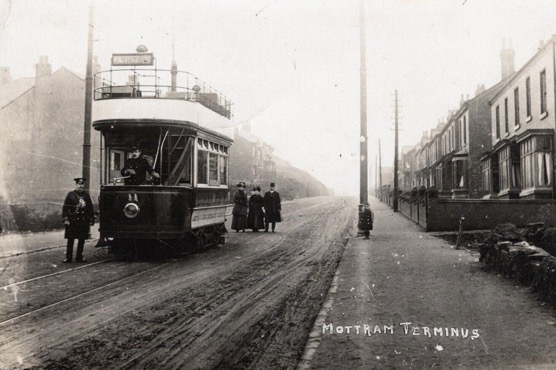
A postcard view of Tramcar No 11 at the terminus at Mottram — photo undated, but probably taken in 1905 when through-running to Mottram (on the SHM&DT system) began. Author's Collection.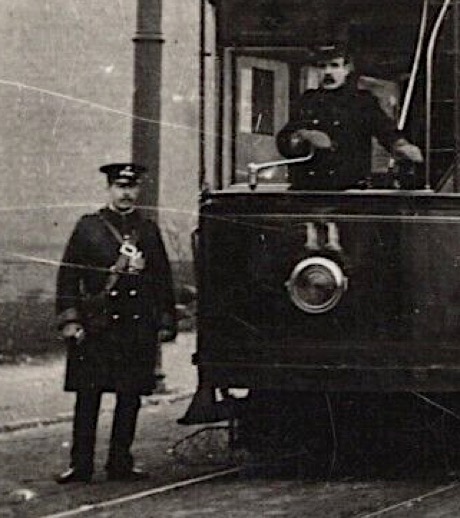
An enlargement of the above photograph showing the conductor and the motorman, both of whom are wearing double-breasted greatcoats and tensioned-crown peaked caps. The latter bear script-lettering grade badges, along with a small municipal-device badge.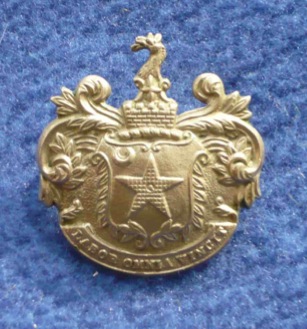
Ashton-under-Lyne Corporation Tramways municipal device badge — nickel. This pattern of badge was almost certainly that worn by tramcar crews on their caps, and in later years, on their uniform jacket collars. Author's Collection.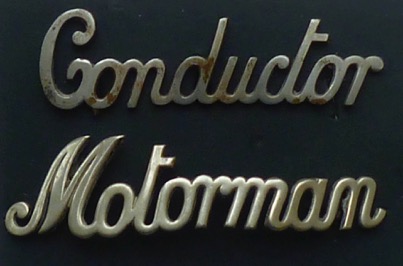
Standard off-the-shelf, script-lettering grade badges of the type worn on the caps of Ashton-under-Lyne Corporation Tramways staff — nickel. Author's Collection.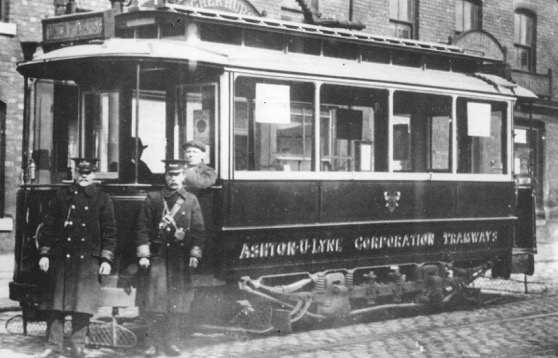
A motorman and conductor with Tramcar No 15 in Kings Street, Higher Hurst — photo undated, but probably taken around the time of the Great War. Author's Collection.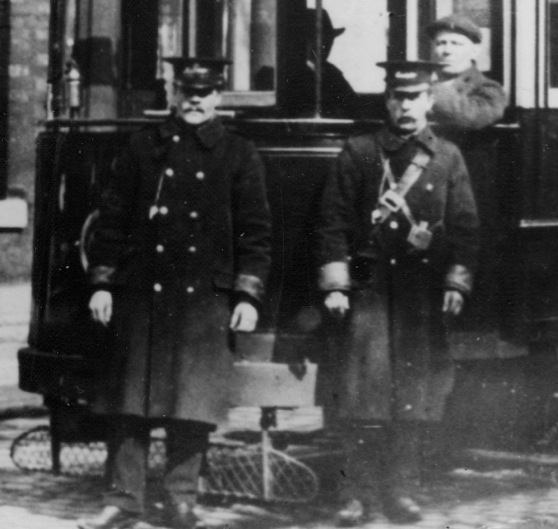
An enlargement of the above photograph showing the motorman and conductor. Both men are wearing standard, off-the-shelf, script-lettering grade badges, 'Motorman' and 'Conductor', along with a municipal-device badge.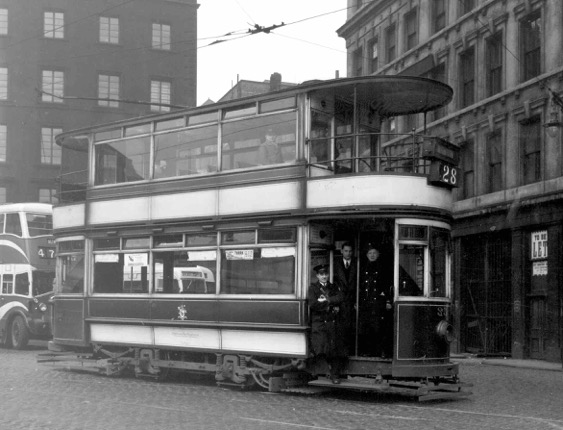
The crew of Tramcar No 35 at Manchester Piccadilly with Service No 28 for Ashton — photo undated, but probably taken in the mid 1930s. Photo by W A Camwell, courtesy of the National Tramway Museum. 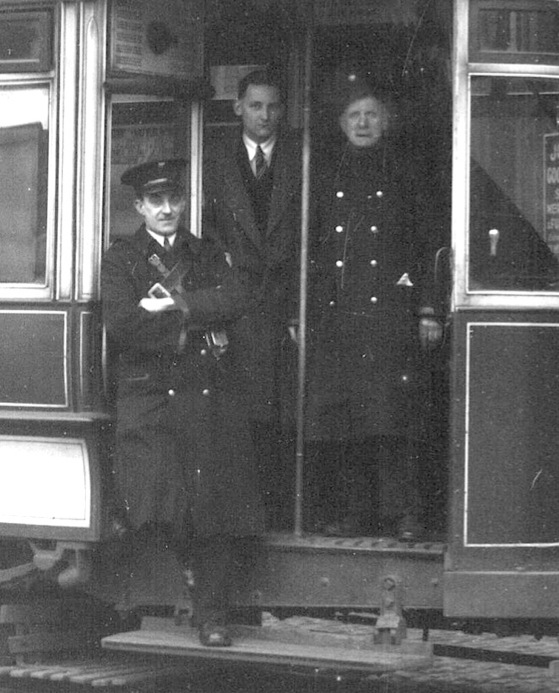
An enlargement of the above photograph showing the conductor and the motorman. The Ashton municipal-device cap badge can just be seen under the crown of both men's caps.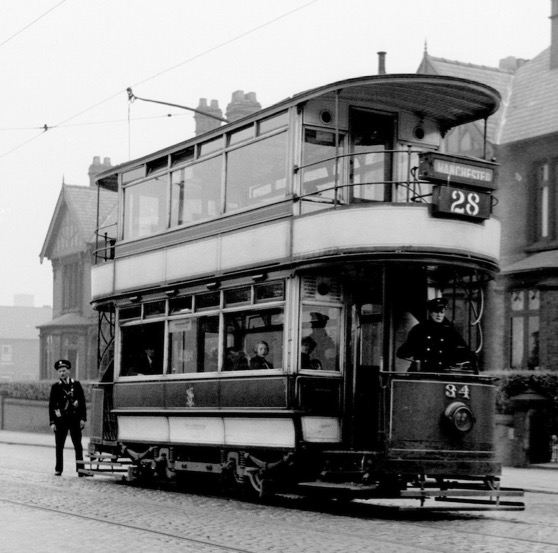
The crew of Tramcar No 34 pose for the camera of W A Camwell in Audenshaw — photo undated, but probably taken on the same day as the preceding photo in the 1930s. Photo courtesy of the National Tramway Museum. 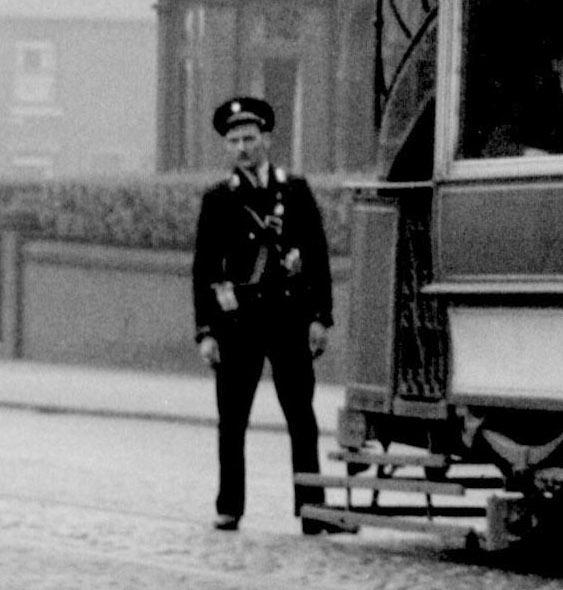
An enlargement of the above photograph showing the conductor; he is wearing the more modern style of double-breasted jacket introduced in the late 1920s or 1930s. His tensioned-crown peaked cap carries only a municipal-device badge.
Senior staff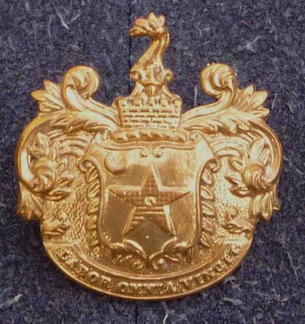
Ashton-under-Lyne Corporation Tramways municipal-device badge — gilt. It is possible, though by no means certain, that senior staff wore these gilt badges on their caps. Author's Collection.
Female staff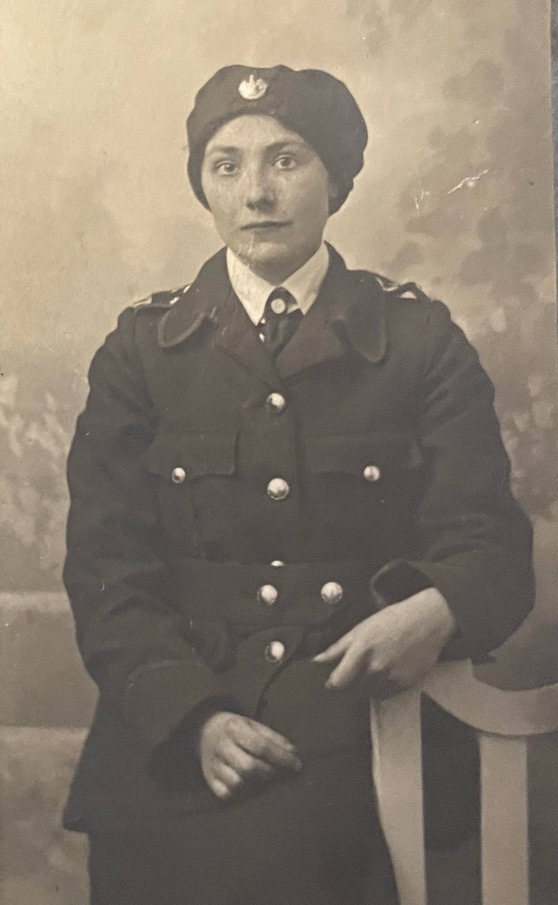
A rare studio portrait of an Ashton-Under-Lyne Corporation Tramways Great War conductress, taken in August 1917. The subject is Annie Partington, later Hoolahan. Photo taken in the studios of Norman Lister of 278 Stamford St, Ashton-under-Lyne. Photo courtesy of Annie's grand-daughter, Irene Fitzpatrick.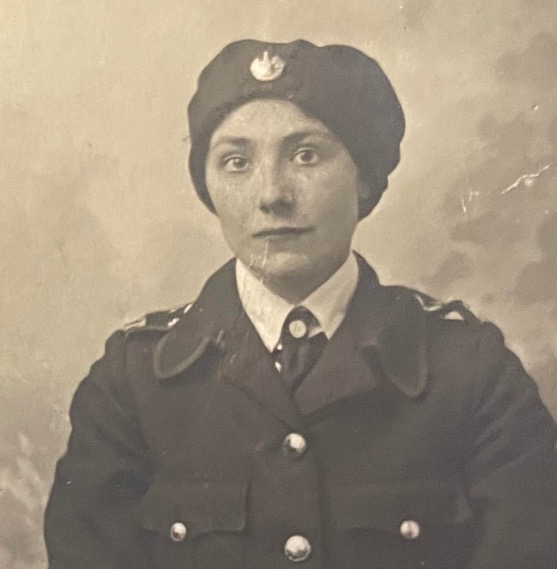
An enlargement of the above photograph showing details of the uniform insignia. Although it cannot be stated with certainty, the epaulettes appear to bear system initials and maybe, an employee number.